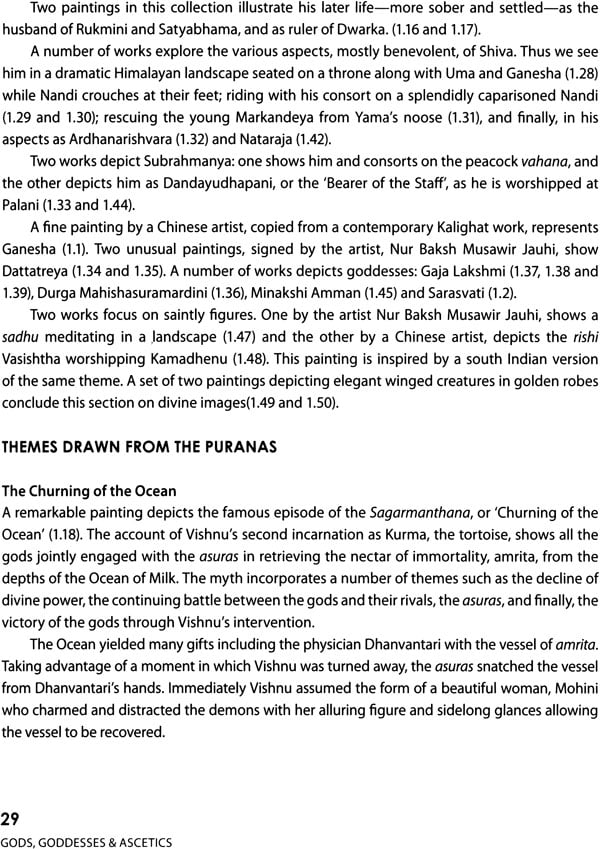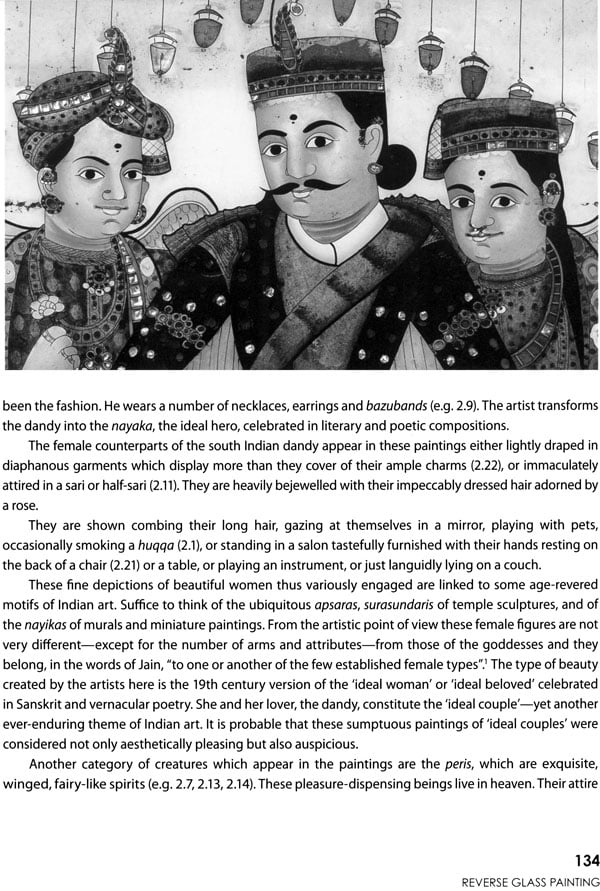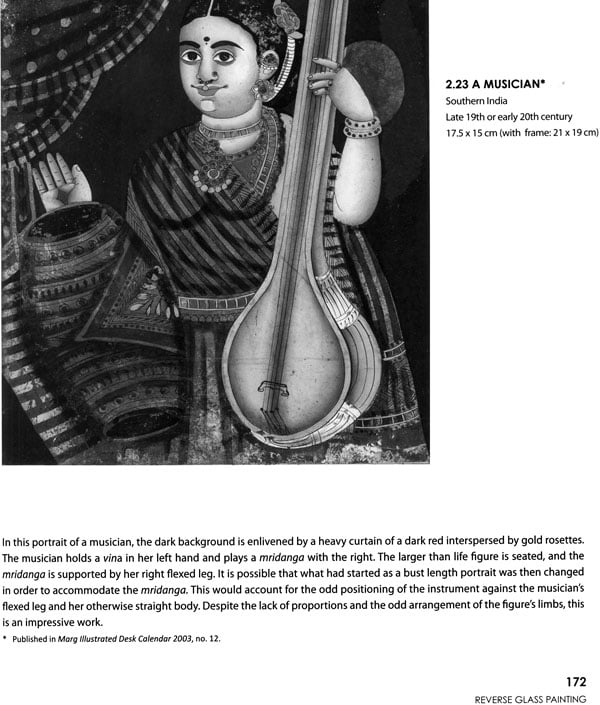
| Item Code: | NAN304 |
| Author: | A.L. Dahmen Dallapiccola |
| Publisher: | Niyogi Books |
| Language: | English |
| Edition: | 2017 |
| ISBN: | 9789385285349 |
| Pages: | 252 (Throughout Color and B/W Illustrations) |
| Cover: | Hardcover |
| Other Details | 9.0 inch X 9.0 inch |
| Weight | 1.20 kg |
Reverse glass painting is a fascinating yet comparatively unknown facet of Indian art that flourished in the mid-19th century. Created by Chinese and Indian artists, these exotic painting in luminous colours were much favoured by royal patrons, and also by prosperous landowners and city merchants in colonial India. The themes ranged from portraits of rulers, their families, nobles dancers and courtesans, to landscape and a wide variety of religious subjects drawn from the Puranas and the Epics. Many of the portraits depict western style settings and offer a charming insight into the tastes and lifestyle of the western-educated urban elite in mid-19th and early 20th century India.
About the Author
Professor Anna L. Dallapiccola Has a Ph.D in Indian Art History and a Habilitation (D.Litt.) from University of Heidelberg, Germany. She was Professor of Indian Art at the South Asia Institute of Heidelberg University from 1971 to 1995, and then appointed as Honorary Professor at Edinburgh University in 1991. She lectures at the School of Oriental and African Studies, London. From 2000 to 2004 she was Visiting Professor at De Montfort University Leicester.
Among her latest publications are Catalogue of South Indian Paintings in the Collection of the British Museum (2010), The Great Platform at Vijayanagara (2010), and Kalamkari Temple Hangings, a study of the collection in the V&A (2015).
She has at present two concurrent research programmes in India, the first on the art of the Vijyanagara successor states, and the second on the Virabhadra temple at Lepakshi.
A Brief Overview of Indian Painting
"Painting is the best of all arts, conducive to dharma, pleasure, wealth and emancipation. It gives great pleasure when placed in a house. (Vishnudharmattara, Ch. 43, v. 38)
Although very little remains of early Indian painting, a wealth of information on its relevance in contemporary culture can be gleaned from literary sources. Paintings adorned homes, public buildings and temples; cultured citizens were not only expected to appreciate the fine arts but also to be able to draw.
Vatsyayana's Kamasutra (c. 3rd century CE) informs us that painting should be among the accomplishments of a nagaraka, a man-about-town. In his home, among other appurtenances, there should be a vina, a board to draw or paint on, a box of pencils and some book - probably a book of poetry to be read aloud. (Kamasutra, 2002:17)
Indian artists developed many painting formats, the oldest of these being wall paintings' and painting on cloth. Literary evidence testifies to the existence of pictures on cloth that were displayed during religious festivals. Surviving examples of this genre belong to the eighteenth or nineteenth century. Among these are epic and puranic narratives used by storytellers to illustrate their performances, astrological scrolls, and paintings depicting holy sites and deities. The latter were made for religious institutions, and also as souvenirs for sale to pilgrims. Elaborate painted textile scrolls with edifying religious narratives were used by monks to transmit ethical and spiritual values to their audience. A popular genre among painted scrolls seems to have been the yamapattas that illustrated in detail the torments awaiting sinners in hell.
Painted manuscripts, the earliest of which date to around the eleventh century, are another prolific painting format.' They were executed on the leaves of the talipot palm (Carypha umbraculifera). Once the paintings were completed, the leaves were stacked and strung with two strings drawn through pre-bored holes. Two wooden covers-at the top and at the bottom- protected the pile of leaves. This type of manuscript is known as a pothi.
After the arrival of the Muslims in the late twelfth and early thirteenth century, palm leaf manuscripts were replaced by paper. The Islamic courts favoured the vertical or codex format, while the horizontal or pothi format was maintained by both Hindus and Jains up to the eighteenth century.
By far the most famous and prolific Indian pictorial output, closely connected to manuscript illumination, is miniature painting executed in opaque watercolour on paper. It is not known when this format was adopted, but it is likely to have been around 1400 when paper became readily available. Until this point the artists were constrained by the dimensions of the talipot leaf but the the new medium of paper allowed them to create larger, more ambitious compositions. Series of unbound pictures illustrating literary, historic, religious and romantic subjects were produced en masse. However, the Mughals favoured albums bound either in leather or lacquer covers, containing miniatures and calligraphy specimens mounted on card. With the dissolution of the Mughal empire and the decline in provincial administration, indigenous patronage rapidly declined.
The next phase in the development of Indian painting was ushered in by the British. The first wave of newcomers in the 16th century consisted mainly of adventurers, traders and mercenaries not particularly interested in cultural activities. The consolidation of British power in the 18th and 19th centuries led to the arrival of army officers, lawyers, civil servants and other cultured people in sizeable numbers. Many of them were captivated not only by the picturesque side of India but also by its history, literature, religion and monuments. As a result, the amateur painters among them sketched whatever appeared to be worthy of being recorded.
Indian artists were quick in realizing a potential market and they carefully studied Western prints and drawings. Some of them perfected their skills by serving as draftsmen to the engineers of the East India Company, others were employed by British botanists and zoologists and produced a vast amount of drawings documenting the flora and fauna of India. Yet others were coached by the British in the first art schools. As a result of this direct interaction, Indian artists began to adapt their technique to suit the taste of their British patrons. In effect, they learned to paint in a Westernized manner, thus creating a new, hybrid style known as 'Company' painting, a genre usually connected with the expansion of British power in India.
It should be noted, however, that the beginning of this 'Westernization' process can be traced back to the early 16th century, shortly after the arrival of the Portuguese on the west coast of India in 1498. Unfortunately, no vestiges of Indo-Portuguese paintings have survived.' thus, in the absence of evidence, it is difficult to assess the Portuguese influence on the development of painting in southern India. Company painting spread throughout the subcontinent, varying from region to region. However, the illustrated themes were similar: sets depicting castes, costumes, trades and crafts, festivals, modes of transport, flora, fauna, monuments and elegant mansions. This prolific pictorial output on paper, ivory and mica offers a varied and carefully observed panorama of Indian life. It was at this point in time that reverse glass painting came into vogue with the local aristocracy and middle classes.
Reverse Glass Painting
Reverse glass painting is a fascinating, yet comparatively unknown genre of Indian art. It flourished in the mid-19th century, a period characterized by international contacts, artists working for British or 'company' patrons and the introduction of new techniques such as watercolour, lithography, and by 1850, photography. Considered, generally a 'folk' art, and as such comparatively unknown to both collectors and scholars, it was very popular throughout Indian society." Eventually, the existence of reverse glass painting was cut short first by the introduction of wood engravings which enjoyed a great popularity in the late 19th century, and then by the introduction of chromolithographs.
Reverse glass painting originated in Europe and was widely used mainly to illustrate religious themes. In the course of the 16th century its technique was refined and simplified in Italy, probably in Venice, from where spread throughout Europe from Spain to Poland. During the 17th and 18th centuries this form of art was greatly appreciated and eventually patronized by the Church and the nobility of Central Europe. One of the most celebrated examples is the magnificent mid-18th century Spiegelkabinett ('Hall of Mirrors') at the residence of the Prince- Bishop in Wuerzburg, Germany.
Apart from these masterpieces displaying a consummate virtuosity, most of the reverse glass paintings were executed by not by professional artists but by glaziers, pedlars and amateur painters. In Eastern Europe:
"reverse glass painting had become the favoured medium for votive pictures. The paintings could be finished quickly and sold in great numbers at the sites of pilgrimage. The glass had the added attraction of reflecting the scant light in the dark rooms of the peasant homes. Reverse glass paintings of saints, holy places and miracles were made in great number throughout Europe from 1700 A.D." (Granoff, 1978: 204)
Until the outbreak of World War I reverse glass painting was a thriving folk art in Central and Eastern Europe, but after World War II it fell into oblivion. It was revived only in the 1990s.
The Spread of Reverse Glass Painting from Europe to Asia
In the 16th and 17th centuries great maritime powers such as the Portuguese, the Dutch, the French and the English gradually established a hugely profitable global trade network. Thus, the wares of the east reached the west, and vice versa. In the wake of expanding overseas trade, foreign companies established factories on the coasts of India. Although their main concern was establishing commercial links with the local powers, more often than not, they interfered in the confused political situation of the host country to establish territorial. political and cultural connections. All this stimulated the curiosity of the 'exotic' both in Europe and in India.
In Europe a craze for 'chinoiserie' and 'turquerie' during the 17th and 18th centuries inspired architecture, interiors, culture and fashion. Among the most popular wares imported from the East were porcelain, lacquer and chintz. In India there was a keen interest in Western manufactures. Apart from weapons, paper and glass India imported luxury goods: mirrors, velvets, chandeliers, and clocks - preferably chiming - most of which ended in the palaces of local rulers whose curiosity for the exotic was insatiable. Mrs Postans" who visited the Aina Mahal in Bhuj in the 1830s writes:
" ... [the reader should] imagine himself introduced, by some wholesale glass dealer, to his sample room, where, amongst jelly glasses, and old vases, are introduced some half dozen antique musical clocks, all playing at once, and the whole display brilliantly illuminated by large wax candles, at noon-day! The mental picture may then afford him of some idea of this motely and incongruous melange of ornament, which contributes to the regal magnificence of this most dazzling of state apartments." (Postans, 1839: 39-40)
Among the various imported exotic artefacts and collectables were reverse glass paintings from China which seem to have reached the west coast of India in the second half of the 18th century.
"It would appear that more than the import of original paintings, it was the arrival of foreign artists who practised this technique that in fact set in motion a movement for the production of paintings on glass. So far as can be ascertained these painters were not from Europe, the original home of glass painting, but from China. These artists were not the traditional artists of China but artists who practised a commercial kind of art for export. "(Appasamy,1980:3)
The technique of reverse glass painting was probably introduced into China in the 17th and 18th centuries by Jesuit missionaries. One of the key figures among them was the Italian Jesuit Giuseppe Castiglione (1688-1766) who had worked as a muralist in Italy and Portugal. He was active at the Qing court for fifty years, creating a new aesthetic which combined Western realism with traditional Chinese conventions. In 1735 Castiglione was appointed as the principal court painter by the newly enthroned Qialong Emperor ?
Contents
| Acknowledgements | 1 | |
| Introduction | 9 | |
| Section I | Gods, Goddesses & Ascetics | 24 |
| Section II | Dandies & Courtesans | 130 |
| Section III | Kings, Nobles & Other Portraits | 186 |
| Section IV | Landscapes & Other Thems | 228 |
| Glossary | 242 | |
| Bibliography | 248 | |
| Index | 250 |
















Send as free online greeting card
